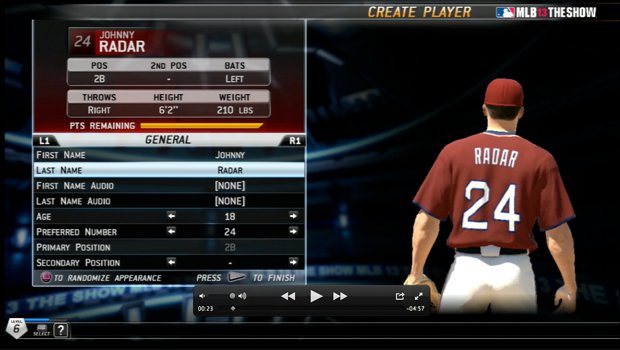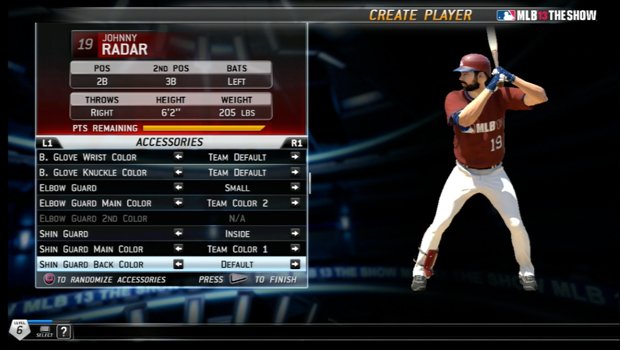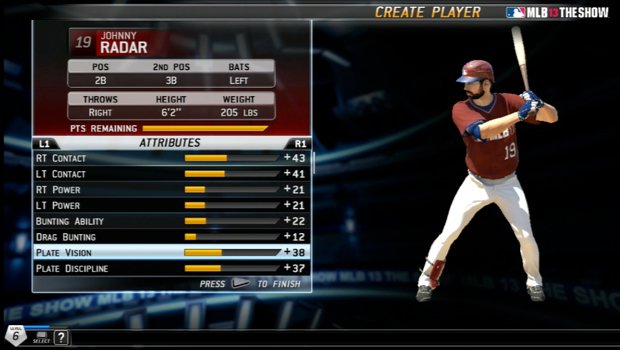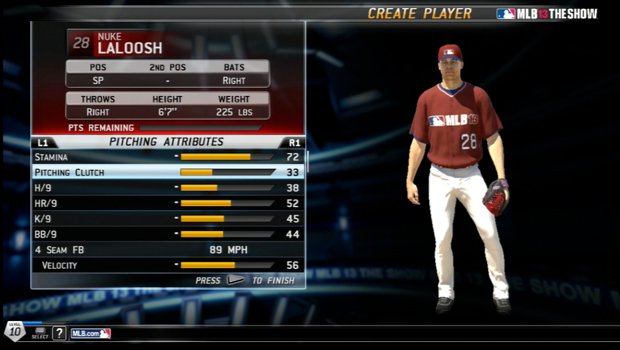MLB 13: The Show road to the show guide

RATING YOUR POTENTIAL
Before you even have to start worrying about which team to sign up with (or to enter the draft and hope for the best), you’ll have to establish your created player’s ratings. The first thing you’ll do is choose a position, batting hand, and throwing hand. We included the teams and position chart first to give you a better idea of what you want to do before you begin because once you choose your position and preferred hands, you’re locked in for that particular created character.
The next step is figuring out just what kind of baseline prospect you’ll be. There are six categories, divided into three sliders. Speed and strength are grouped, as are contact and power, and glove and arm. What you’re selecting on these sliders isn’t what you’ll be rated exactly; it’s more along the lines of choosing which areas you want a head start in when your career begins. You can adjust these to whatever liking you prefer, but we’ve also created a breakdown of how you should lean to best replicate actual MLB talent. We’ll indicate whether to heavily favor (90/10), moderately favor (70/30), or conservatively favor (60/40) one of the six areas.
First base: Strength (Heavily), Glove (Heavily), Power (Heavily)
Second base: Strength (Moderatetly), Glove (Heavily), Power (Moderately)
Shortstop: Speed (Moderately), Glove (Moderately), Contact (Moderately)
Third base: Strength (Heavily), Glove (Moderately), Power (Heavily)
Left/Right field: Strength (Moderately), Arm (Moderately), Power (Heavily)
Center field: Speed (Heavily), Glove (Heavily), Contact (Heavily)
Catcher: Strength (Heavily), Arm (Conservatively), Power (Heavily)
Pitchers have a slightly different set of preliminary statistical categories you can choose from. Both closers and starters again have six total (stamina, power, control, movement, balanced approach, dominant pitch), with each paired off with another. Again, we will indicate whether to heavily favor, moderately favor, or conservatively favor based on our ideal prospect. Feel free to adapt these to any ideal you have.
Starting pitcher: Stamina (Heavily), Control (Moderately), Dominant Pitch (Moderately)
Closing pitcher: Power (Heavily), Movement (Moderately), Dominant Pitch (Heavily)
While the position player choices end after setting the sliders, pitchers then get to choose three pitches that will make up their repertoire. You can choose from any of the available pitches in the game. As a starter, it’s really up to you as to what kind of pitcher you want to be. A more crafty (ex- Roy Halladay) pitcher would likely have a variety of breaking balls, while a more aggressive starter (ex – Stephen Strasburg) would lean on fast pitches with hard movement. If you decide to go the closer route, you’ll definitely want an establishing fastball of some sort (cutter, two-seamer), but will rely heavily on your big “out pitch.” For that, we’d recommend a big slider or nasty splitter.

Now that you’ve established your core fundamentals, it’s time to customize your player. None of the physical appearance stuff has any bearing on your effectiveness at the plate or in the field, so go as crazy with the beards and eye-black as you want. There’s no sense in being as normal and boring as every other player on the field. You want to stand out, and really make your character yours.
Once you’ve settled on a look (which you can always alter at any point, unlike your throwing hand and position), you’ll have a chance to upgrade the remainder of your attributes. There are seventeen different attributes, all of which will have a baseline influenced by your decisions earlier. You have fifty more points to spread out among these seventeen categories, with the maximum additional allotment being +5.
Weekly digests, tales from the communities you love, and more
We’d recommend boosting all the key areas you already favored in the sliders from earlier first. So if you chose to create power-hitting first baseman, boost you power again. If you were a speedy fielder, boost speed and fielding ability first and foremost. You want to create a player that’s immediately strong in key areas that way you can already have a head start, which will allow you to focus on sharpening your lower rated areas through training and with experience earned during actual games.

Spreading out your fifty additional attribute points evenly doesn’t really do your player much justice. We strongly advise not dumping extra points into base-running aggressiveness, base-running ability, clutch, bunting ability, drag bunting, plate discipline, and plate vision. The only reason you won’t use points on those in this instance is because you’re in total control of you player at the plate and on the basepath. Those areas are entirely dependant on your own ability, and not a set of ratings. Unless of course you plan to simulate a lot of games, in which case those areas will matter somewhat, but not terribly so at the AA minor league level.

For pitchers, deciding where to spend the extra fifty ratings points is a little different. All of the batting, fielding, and baserunning attributes are still there, but pitchers of any sort also have their own set of specialized attributes. It can be really tempting to dump the points into your batting contact and power stats, but it doesn’t really serve any purpose at the minor league level. A large percentage of the AA teams use a designated hitter, meaning you won’t come to the plate with any sort of regularity. There will be opportunities during the season to improve the hitting of your created pitcher, so it’s best to spend your limited extra experience on more pertinent stat areas.
There are fifteen pitcher specific attributes to add more points to, with the same +5 max allowed per category. The first four categories to dump extra into should be your H/9 (hits per 9 innings), HR/9 (home runs per), K/9 (strikeouts per), and BB/9 (walks per). Boosting those stats immediately gives you a better chance at lowering the amount of hits, walks, and homers you give up, while increasing the chances the computer will swing and miss at given pitch. Starters should add more to stamina, while closers should add more to pitching clutch. The remaining nine attribute areas (velocity, control, break/movement) are split three each among your three pitches. You should have 25 experience points left to fill in those nine spots however you see fit. It does pay to fill out your dominant pitch with the best possible stats first, but at this junction it’s really personal taste as to how effective you want a particular pitch to be.
Now all that’s left to do is join a team, and start your season.
TABLE OF CONTENTS
- Page 1: Introduction
- Page 2: Position Selection
- Page 3: Rating Your Potential
- Page 4: The Season
- Page 5: Gameday Tips
- Page 6: Training/Meeting Goals


